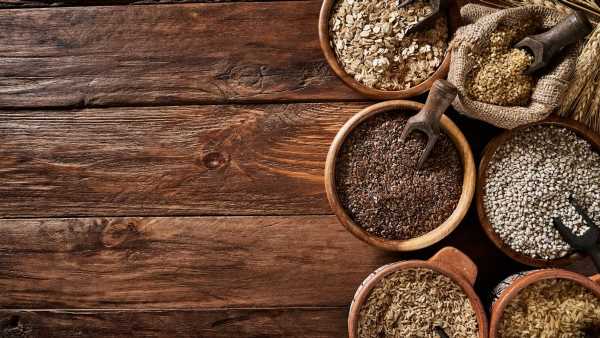Grains that are gluten-free tend to be easier on digestion, especially for people who are intolerant or sensitive to gluten. The protein – found in grains wheat, rye and barley – helps foods to maintain their shape, acting a bit like glue holding them together.
Gluten is in a wide range of foods, even ones you wouldn’t expect including soy sauce, pickles and some hot chocolates. Food labeling can often confuse matters, as just because something is called ‘wheat-free’, doesn’t mean it’s gluten-free.
“Some people have a chronic condition called celiac disease, an autoimmune disease which leads to inflammation in the gut and destroys the intestinal villus, the tiny hair-like projections that line the inside of the small intestine that help to absorb nutrients,” says nutritionist Signe Svanfeldt, from nutrition app Lifesum. “People with celiac disease need to avoid gluten (wheat, rye and barley) from their diet.”
“People can also be sensitive to foods that contain gluten and may want to reduce their intake, as it could lead to stomach ache and other digestive issues,” adds Svanfeldt. “Sensitivity to these foods should, however, not be confused with celiac disease, which is a worse condition.
“There has been an on-going trend to eat a gluten-free diet, but there is no need to do so if you are not suffering from a disease, wheat allergy or other condition where you need to exclude gluten from your diet.”
While most commonly consumed grains in the US contain gluten, there are plenty that don’t. Here are eight grains that are gluten-free. For more meal ideas and tips, try out gluten-free diet plan for beginners.
1. Quinoa
Quinoa is a flower plant, rich in minerals, vitamins and protein. It is also a complete protein, meaning it contains all of the nine essential amino acids that our bodies can’t make on their own. It’s commonly grown in Peru and can be served in salads or as a side for a stew. Or have it with curry in place of rice.
2. Brown rice
Brown rice is a whole grain and one of the highest quality plant-based proteins. Compared with white rice, it is richer in vitamins, minerals and dietary fiber. This has many health benefits and is perfect to serve with stews and curries, or cold as a salad mixed with crunchy veg.
3. Oats
Oats are a type of cereal grain from the Poaceae grass family of plants. Oats alone do not contain gluten, but they are often produced in the same environment as products that do. If you have celiac disease, look for gluten-free options to avoid traces of gluten in the product. Oats are great to use when baking, in oatmeal or pancakes.
4. Corn
Corn is a whole grain and extremely nutritious as it is packed with vitamins, minerals and fiber. It can be used in many different ways and is particularly good for baking. Polenta, which is made from corn, can be cooked in many different ways – ‘wet’ polenta can be a substitute for mashed potatoes, you can use it to make fries or cake, or even instead of breadcrumbs when you crumb a fish or other food.
5. Buckwheat
Buckwheat belongs to the family of herbs. There are multiple ways to use this type of grain, which is rich in fiber, minerals and vitamins. The whole buckwheat is excellent to roast in the oven and add to granola, on top of salads or sprinkle over your oatmeal or smoothie bowl. The flour is great to use in pancakes (the French crepe is originally made from buckwheat flour), or baking, or in oatmeal instead of oats.
6. Millet
This is a cereal grain that belongs to the Poaceae plant family. It’s commonly used in Africa and Asia and while it might look a bit like a seed, its nutritional status is more similar to the cereal grain sorghum. Treat millet like rice and eat with a curry or dal as a side dish. It’s also great to bake with, or you can add it to a salad or make oatmeal with it.
7. Amaranth
Amaranth is considered a whole grain despite not being part of the Poaceae family. Rich in vitamins, minerals and fiber, whole amaranth works well in salads or as a side dish for stews and curries. Amaranth flour can be mixed with other flours to use in bread, muffins and pancakes or as a gluten-free thickener for soups and sauces.
8. Teff
A delicious and tiny cereal grain commonly used in Somalia, Eritrea and other African countries, teff is an ancient grain believed to date back to around 4000 and 1000 BC. You can cook it and eat it as a whole grain, or ground it into flour to use in bread, for example the traditional Ethiopian injera flatbread. It also makes a good alternative to rice or couscous.
Maddy Biddulph
Maddy is a freelance journalist and Level 3 personal trainer specializing in fitness, health and wellbeing content. She has been a writer and editor for 22 years, and has worked for some of the UK’s bestselling newspapers and women’s magazines, including Marie Claire, The Sunday Times and Women’s Health. Maddy loves HIIT training and can often be found working out while her two young daughters do matching burpees or star jumps. As a massive foodie, she loves cooking and trying out new healthy recipes (especially ones with hidden vegetables so the kids eat them).
Source: Read Full Article

